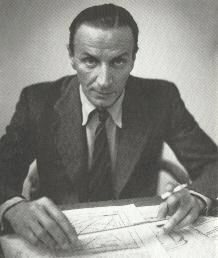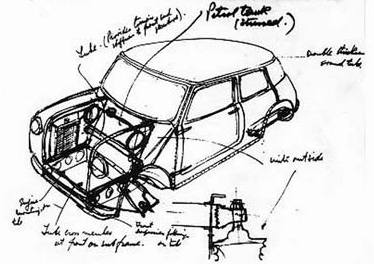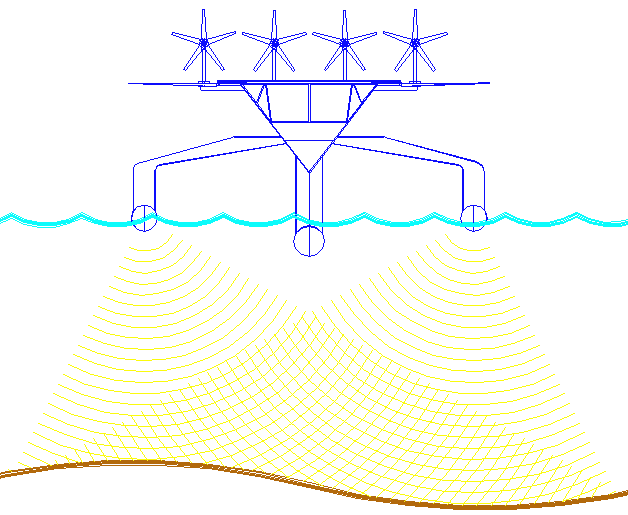|
SIR ALEC ISSIGONIS 1906 - 1988
|
|||
|
Sir Alexander Arnold Constantine Issigonis, CBE, FRS (November 18, 1906–October 2, 1988) was a Greek-British designer of cars, now remembered chiefly for the development of the Mini, launched by the British Motor Corporation (BMC) in 1959.
Alec Issigonis
Alexander Issigonis was born into the Greek community of Smyrna (now Izmir) in Ottoman Turkey. His grandfather Demosthenis Issigonis migrated to Smyrna from Paros in the 1830s and through the work he did for the British-built Smyrna-Aydin Railway, in the engineering works that he had established, had managed to acquire British nationality. Demosthenis's son (Alec's father) Constantine Issigonis (Κωνσταντίνος Ισηγόνης), was born, with British nationality, in Smyrna in 1872. Constantine studied in England, and later, passed his love of all things English on to his son. Alec's mother, Hulda Prokopp, could trace her origins back to Württemberg (now part of Germany).
Because Alec and his parents were British subjects, they were evacuated to Malta by British Royal Marines in September, 1922, ahead of the Turkish re-possession of Smyrna at the end of the Greco-Turkish War (1919-1922). Following the death of his father in 1922, Alec and his mother moved to the UK in 1923. Alec studied engineering at Battersea Polytechnic in London. He failed his mathematics exams three times and subsequently called pure mathematics 'the enemy of every creative genius'.
Issigonis went into the motor industry as an engineer and designer working for Humber and did some motor racing during the 1930s and 1940s. In 1936 he moved to the Morris Motor Company at Cowley working on an independent front suspension system for the Morris 10. The war prevented this design from going into production but it was later used on the MG Y Type. He worked on various projects for Morris through the war and towards its end started work on an advanced post war car codenamed Mosquito that became the Morris Minor, which was produced from 1948 until 1971. In 1952, just as BMC was formed by the merger of Morris and the Austin Motor Company, he moved to Alvis Cars where he designed an advanced saloon with all aluminium V-8 engine, and experimented with interconnected independent suspension systems. This prototype was never manufactured because its cost was beyond Alvis's resources.
Issigonis sketch of the Mini
At the end of 1955 Issigonis was recruited back into BMC - this time into the Austin plant at Longbridge - by its chairman Sir Leonard Lord, to design a new model family of three cars. The XC (experimental car) code names assigned for the new cars were XC/9001 - for a large comfortable car, XC/9002 - for a medium-sized family car, and XC/9003 - for a small town car. During 1956 Issigonis concentrated on the larger two cars, producing several prototypes for testing.
However, at the end of 1956, following fuel rationing brought about by the Suez Crisis, Issigonis was ordered by Lord to bring the smaller car, XC/9003, to production as quickly as possible. By early 1957 prototypes were running, and by mid-1957 the project was given an official drawing office project number (ADO15) so that the thousands of drawings required for production could be produced. In August 1959 the car was launched as the Morris Mini Minor and the Austin Seven. In later years the car would become known simply as the Mini. Due to time pressures the interconnected suspension system that Issigonis had planned for the car was replaced by an equally novel, but cruder, rubber cone system. The Mini went on to become the best selling British car in history with a production run of 5.3 million cars. This ground-breaking design, with its front wheel drive, transverse engine, sump gearbox, 10-inch wheels, and phenomenal space efficiency, was still being manufactured in 2000 and has been the inspiration for almost all small front-wheel drive cars produced since the early 1960's.
An XC/9003 prototype Mini
In 1961, with the Mini gaining popularity, Issigonis was promoted to Technical Director of BMC. He continued to be responsible for his original XC projects. XC/9002 became ADO16 and was launched as the Morris 1100 with the Hydrolastic interconnected suspension system in August 1962. XC/9001 became ADO17 and was launched, also with the Hydrolastic suspension system, as the Austin 1800 in October 1964.
Issigonis (nicknamed "The Greek god" by his contemporaries) was elected as a Fellow of the Royal Society in 1967 and was awarded a knighthood in 1969. Whilst he is most famous for his creation of the Mini, he was most proud of his participation in the design of the Morris Minor. He considered it to be a vehicle that combined many of the luxuries and conveniences of a good motor car with a price suitable for the working classes - in contrast to the Mini which was a spartan mode of conveyance with everything cut to the bone.
Sir Alec officially retired from the motor industry in 1971, although he continued working until shortly before his death from Parkinson’s Disease in 1988.
LINKS
INVENTORS A - Z
The ultimate Robot Boat. Solarnavigator uses an advanced SWASSH hull as the platform to mount the world's first autonomous circumnavigation. A successful expedition could pave the way for improved safety at sea.
|
|||
|
This website is copyright © 1991- 2013 Electrick Publications. All rights reserved. The bird logo and names Solar Navigator and Blueplanet Ecostar are trademarks ™. The Blueplanet vehicle configuration is registered ®. All other trademarks hereby acknowledged and please note that this project should not be confused with the Australian: 'World Solar Challenge'™which is a superb road vehicle endurance race from Darwin to Adelaide. Max Energy Limited is an educational charity working hard to promote world peace.
|
|||
|
AUTOMOTIVE | BLUEPLANET BE3 | ELECTRIC CARS | ELECTRIC CYCLES | SOLAR CARS | SOLARNAVIGATOR |



